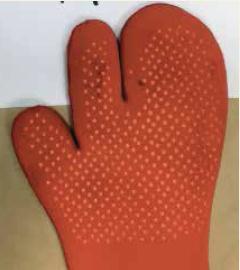201355 Foundering at night
Edited from official MAIB report 12/2013
In darkness and heavy seas, a small general cargo ship began to founder. Although a Mayday message was broadcast on VHF radio channel 16, Digital Selective Calling (DSC) was not used. The voice Mayday call was short and incomplete.
After the general alarm was sounded, the crew assembled on the bridge and donned immersion suits collected from two decks below. These were a mix of different types - some of the suits were required to be donned with lifejackets, others were not. As the vessel’s freeboard reduced, the Master realised that the vessel was sinking and ordered the crew to prepare to launch the liferafts. At about the same time, the second officer collected the two search and rescue transponders (SART).
However, he had difficulty activating them because of the design of the gloves integral to his immersion suit (see picture below), and eventually had to use his teeth to operate them.
Less than 20 minutes after suffering a catastrophic structural failure, the vessel foundered. Two crew survived, climbing into a liferaft that had inflated after the vessel sunk beneath them. The Master and five crew perished. About an hour after the vessel foundered, a rescue helicopter arrived on scene and spotted the two survivors in the liferaft, winching them to safety.
Safety lessons
Abandoning ship in the middle of the night in rough seas is a situation no seafarer wants to experience. Unfortunately, many do, and although SOLAS requirements place a great deal of emphasis on the importance of life saving appliances (LSA) and abandon ship drills, tragically lives continue to be lost. To improve the likelihood of all crew surviving should the need to abandon ship arise, vessel owners, managers and crews are strongly advised to take into account the lessons to be learned from this accident.
In particular:
* The importance of ensuring that all crew are fully briefed on mustering procedures and that they are able to properly don the immersion suits and lifejackets available through regular and realistic abandon ship drills.
* The benefits of transmitting distress messages in the recommended and internationally recognised format. This can quickly and accurately be achieved via digital selective calling (DSC), but in situations in which the use of voice procedures is preferred, a simple aide-mémoire, showing the format and information required, is a straightfoward and cost-free option.
* Having several different types of immersion suit and lifejackets on board is potentially confusing and increases the risk of the equipment either being donned incorrectly or not quickly enough. It is common sense that all of the immersion suits provided on board a vessel should be of the same type; i.e. either they all have in-built buoyancy, or they all need to be worn with a compatible lifejacket, but not a mix of the two designs. Even in large fleets that carry many types of suits and lifejackets, this can usually be arranged through good planning.
* The provision of life saving apparatus (LSA) should be goal-based and holistic in order to ensure that the components are compatible and that the ‘system’ is fit for purpose. The compatibility of individual items of equipment cannot be taken for granted, even where the LSA provided meets the required performance standards.

